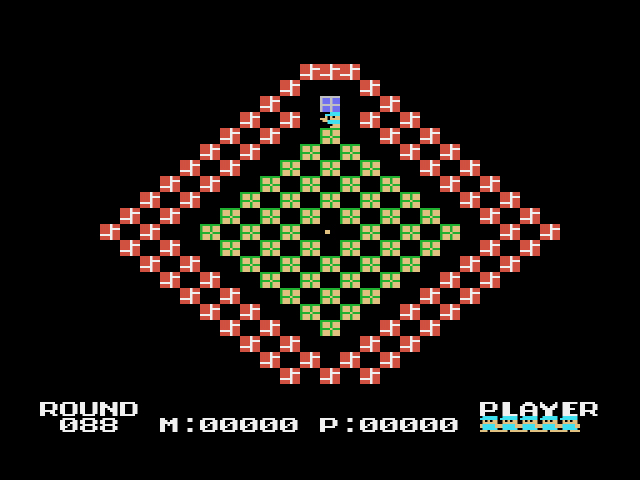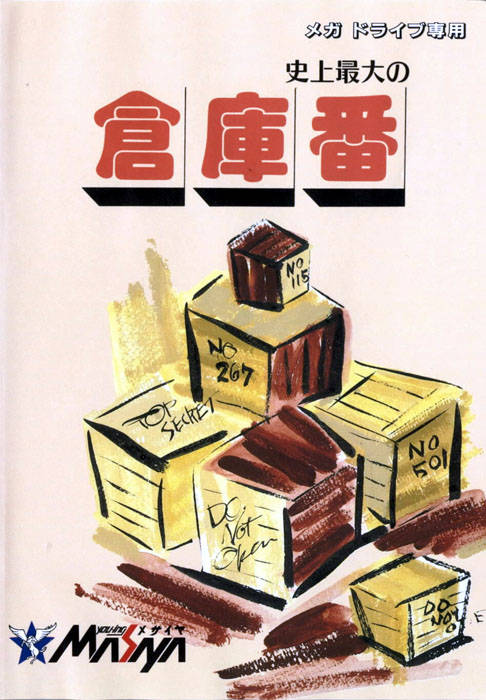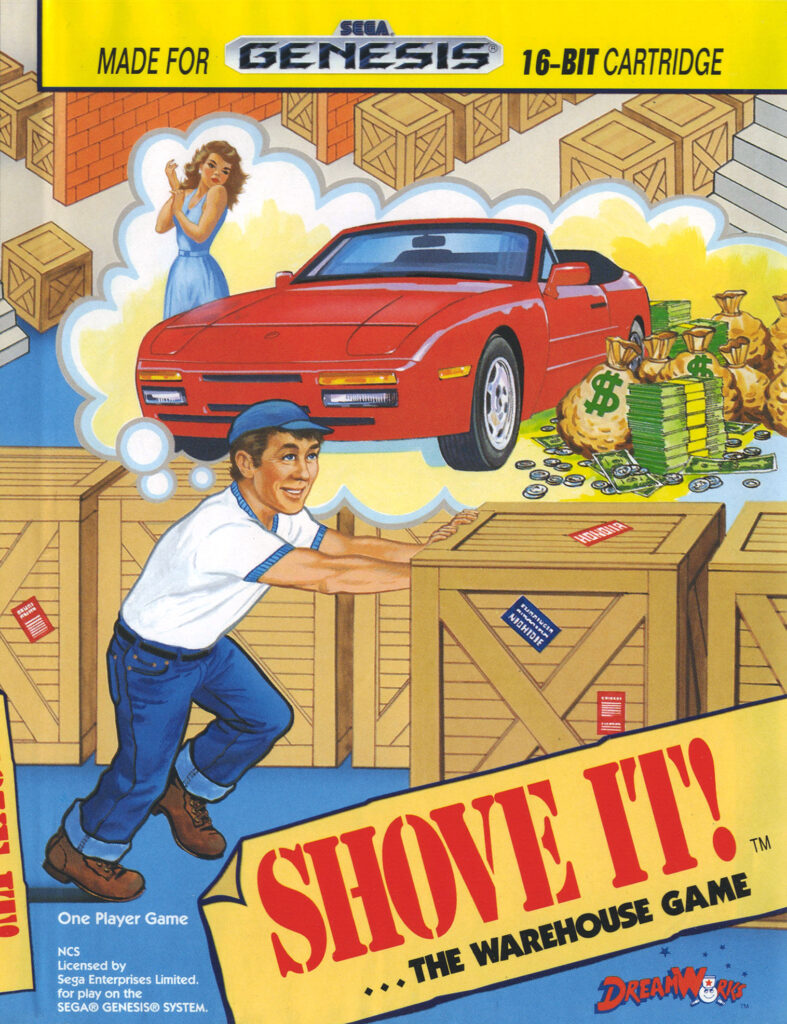
PLAYERS: 1
PUBLISHER: Sega
DEVELOPER: Thinking Rabbit (port by Sega)
GENRE: Puzzle
RELEASE DATE: 1985 (JP)
Bolting down moving platforms in Rock n’ Bolt. Traveling down thirty floors in an elevator in Elevator Action. Moving boxes around confined corridors in Soukoban. Thrilling concepts for video games? Nay. But all three games share a curiously addictive nature that belies one’s initial impressions.
In Soukoban, you play as a construction worker who has to push boxes to a certain location in a warehouse. This sounds simple, but from the first stage onward, Soukoban commands you solve its strict, unforgiving puzzles in a very particular way. Since you can only interact with the boxes through pushing them (no pulling or lifting), each move must be carefully considered prior to execution. The boxes are usually clustered near each other, sometimes placed in layers. You’ll often have to push boxes in directions that don’t initially make sense in order to “free” other boxes. If you accidentally push a box into a direction or placement from where it can’t be recovered, you’ll have to restart the level all over again. Never have the words “trial and error” so readily applied to a game.

So why would anyone play such a brutal box-pushing simulator on the SG-1000? Well, like any puzzle game worth its salt, Soukoban teaches as much as it punishes. After a couple levels of screaming “What do you want from me?!”, you’ll begin to pick up on the game’s idiosyncrasies and push boxes in the direction the game wants you to. You’ll still fail – will you ever! – but success will not appear as elusive the further you progress. And when you inevitably start over, you can select any of the hundred levels to start from on the main menu screen. Even Sega knows Soukoban is hard as sin.

In addition to pushing boxes around meticulously crafted levels, Soukoban has a level editor. The editor has all the necessary features – walls, boxes, places to put the boxes – but Soukoban is so restrictive by nature that, unless your mind naturally thinks like the developers, you won’t be making reasonable levels without insane amounts of practice. And when you make a level that’s creative and clever and you want to show your friends, you’re not able to save. Lest you forget, you’re playing on the SG-1000, and as Gollum would say, “What’s a battery backup, precious?”


PLAYERS: 1
PUBLISHER: Masaya (JP), DreamWorks (US)
DEVELOPER: Thinking Rabbit (port by NCS)
GENRE: Puzzle
RELEASE DATE: 01/30/90 – (JP), 05/90 – (US)
Our journey with Soukoban doesn’t end with the SG-1000 version, however. The Genesis/Mega Drive also received a version of Soukoban in 1990. In America, the game was called Shove It!… The Warehouse Game, while in Japan it was known as Shijou Saidai no Soukoban. The former is certainly a more apt title (hey! You are just shoving boxes in a warehouse!) than Shijou Saidai no Soukoban, even if it was pieced together by an early 90s focus group.
Rest assured, Shove It is pure Soukoban through and through: boxes need pushing and you’re the schmo hired to push ’em proper. The game is structured a bit differently from the SG-1000 version, though. Instead of a hundred levels back to back, Shove It gives one stage at a time, with ten rooms per stage. A “room” is just a level with a different name, and while you can complete the ten rooms in any order you choose, the next stage is only opened after all ten rooms have been completed. Since there are sixteen stages, ten rooms per stage, that makes for 160 levels. After you beat a stage, you’re given a password. Sega didn’t program this port, so there’s none of that “Start anywhere you like” generosity here.

While you still can’t pull boxes backwards, Shove It gives the option to take one move back, which is surprisingly helpful. You can also open a menu during the game that allows you to perform one of several options: ‘Reset’ begins the level over again, ‘Trace Mode’ re-traces your steps prior to the last step before pulling up the menu, and ‘Go’ opens the room selection screen. Shove It also has an edit mode, which is plagued by the same inability to save as the SG-1000 version. I’m sure battery backups made cartridges more expensive, but these edit modes are a tease without some way to save your levels. Unless you have a bulky VHS camcorder at the ready to film your inspired creation, they’ll be gone forever.
Soukoban‘s presence on the SG-1000 in 1985 seems natural, but Shove It feels antiquated for 1990, and particularly on the Genesis. Shove It graphically improves upon its SG-1000 predecessor (as well it should), but it doesn’t build upon soukoban’s minimalist foundation. There’s no power-ups, no special flourishes to take advantage of the new hardware or to give those who played prior versions of soukoban a reason to return. While Shove It is perfectly playable, the game feels like a missed opportunity to expand the limited boundaries of soukoban for a new console generation.

PLAYERS: 1
PUBLISHER/DEVELOPER: RiverhillSoft
GENRE: Puzzle
RELEASE DATE: 12/15/90 – (JP)
The box-pushing craze continues with Soukoban on the Sega Game Gear. Handhelds and Soukoban feel like a somewhat natural fit, particularly handhelds with color (sorry Boxxle). Like Shove It, Soukoban only gives you access to ten rooms at a time, but it does give you a password option after you beat every room. Also, while the walking/pushing speed of the construction worker feels appropriate in each level, he has five different walking speed levels you can cycle through by pressing ‘Start.’
There are three hundred whopping rooms in this go-round, which amounts to approximately 100,000 AA batteries or more, depending on your ability to push boxes in the right direction the first time. Unfortunately, the larger the room layout, the more the camera zooms out from the on-screen action, making the boxes and the construction worker abnormally small at times. Now, I understand why the developers did this: it’s slightly less inconvenient to shrink the on-screen sprites than to add an unbearable amount of scrolling to a couple hundred levels. Still, since Soukoban is already forced to work with the small, blurry Game Gear screen, making the game even smaller and harder to see does not seem like the answer, especially for players with impaired vision.

Well, shove my boxes if I didn’t enjoy the SG-1000 version of Soukoban the best. The Game Gear version’s portability and overabundance of levels makes it a must for soukoban fans on the go, but you’ll need a magnifying glass or a young child’s perfect vision to stumble through the more complex levels. The Genesis version looks the best of the three, but the game should have brought some innovation to traditional soukoban mechanics. The SG-1000 version is basic, sure, but its steel-eyed focus is what makes it feel superior over its brethren. SG-1000 Soukoban is puzzle-solving-by-box-pushing distilled to its purest form, and that ain’t not bad.
SG-1000: B+
GENESIS: B-
GAME GEAR: B-

12 replies on “Soukoban / Shove It!… (Sega, 1985-1990)”
What do you know, it’s Boxy Boy.
I gotta say I kind of like the sokaban puzzle games. It seems like something the SG-1000 could do well based in its simplicity. The only one if these I’ve played was Shove-it (and the gameboy one) I believe those two were the first time they made it to consoles in the US. And shove it was a very early Genesis game. I rented it and generally enjoyed it, just not enough to buy. I would probrably enjoy the SG-1000 game as simplicity in graphics and design seem to help this game.
I enjoy this game enough that when it’s coopted for other genre games, I usually enjoy the box pushing puzzles.
A bit ago I downloaded a ton of weird bootleg games in a torrent pack for my NES emulator and one of them was this weird Russian rip off of this. It was kind of addicting, despite the graphics being the most boring looking I’ve ever seen. It was also appropriately Russian. “Push boxes around warehouse to support mother country! Slacking is treason!”
I remember my 10-year old self playing this on Gameboy during various family road trips in 1990/91…only the game was called Kwirk, and you were an anthropomorphic tomato with a slammin’ green mohawk.
I really liked it, but I’m a sucker for puzzle games.
I remember Kwirk, fun little puzzle game. I think you’re confusing it with Boxxle though.
Is it the same fellow appearing on all the my card game box art ? If it is who is he ?
Perhaps he was Sega’s “mascot” prior to Alex Kidd? I’m not sure. I haven’t been able to find much information about these SG-1000 games that’s not in Japanese.
I don’t think it’s the same person. The wherehouse guy is younger and has no mustache and different hat and shoes. I just think it all has a similar art style.
Or…… You could make your own story.
Wherehouse guy (from here one known as Sal) got his first high school job moving boxes in a wherehouse. He really wanted to be a construction worker but he had to start as a laborer on the bottom. Sal never knew what was in the boxes. He just moved then around. All he wanted was some extra scratch for a new car so he could get a smokin girlfriend. He found thought that he really excelled at efficiently moving his boxes. His bosses were pleased. He planned on going to college next year, but his boss offered him a promotion. Sal started his Iron Worker apprentice job the next day. He also got a big promotion as it was a union job. He got his new car, the money and the girl.
After a few years he achieved his journeyman rating. But all was not well. He crashed his car. His girlfriend left him and taxes and union sues ate up his paycheck. But he loved his job. He shortly became the top performing Iron Worker on all his jobs. He could swing a beam into place and bolt it down on the fly. He also realized that that he was happiest in high school when he had less material things and just jammed out listening to his music. Sal busted out his old converse shoes , his high school cap and his boom box and he was putting up beams faster than ever. He had finally found his groove in life. He did keep his sweet stache though.
Ya. I don’t think they are the same character. (This will be the last imaginary story you ever hear from me , I promise)
Lousy union dues.
Soukoban is tied with Lode Runner on the list of “puzzle games I’m fascinated by even though they destroy me”, second only to the Lolo/Eggerland games.
I guess Lolo is technically a Soukaban game. Or a least a derivative. I love that series too.
I’m pretty sure this was a mini game in No More Heroes 2.